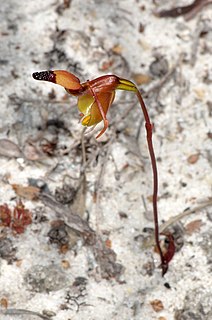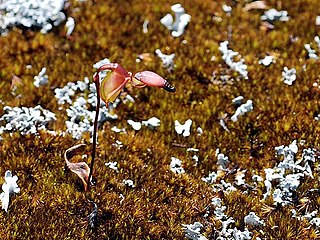
Caladenia integra, commonly known as the smooth-lipped spider orchid is a species of plant in the orchid family, Orchidaceae and is endemic to the south-west of Western Australia. It can be distinguished by its distinctive smooth-edged labellum and its upswept lateral sepals.

Caleana, commonly known as duck orchids, is a genus of flowering plants in the orchid family, Orchidaceae that is found in Australia and New Zealand. The Australian species are found in all states but have not been recorded in the Northern Territory. Duck orchids have a single leaf and one or a few, dull-coloured, inconspicuous flowers. Most species are found in Western Australia but one species occurs in eastern Australia and one occurs in eastern Australia and New Zealand. Orchids in this genus as well as the hammer orchids (Drakaea) are pollinated by male thynnid wasps.

Caleana minor, commonly known as the small duck orchid or flying duck orchid, is a species of orchid native to eastern Australia and the North Island of New Zealand. It has a single reddish brown, grass-like leaf and up to four yellowish to reddish flowers on a wiry flowering stem. The sepals and petals are directed downwards near the broad column wings and the labellum is directed upwards and covered with warty glands.
Caladenia evanescens, commonly known as the semaphore spider orchid, is a species of orchid endemic to a small area near Albany in the south-west of Western Australia. It is a rare species with a single, hairy leaf and one or two cream-coloured to greenish-cream flowers.

Caladenia aperta, commonly known as the western tiny blue china orchid, is a plant in the orchid family Orchidaceae and is endemic to Western Australia. It has a relatively narrow leaf and a single bluish-mauve flower. It is distinguished from the other two similar blue orchids by the sides of the labellum which are erect but well-separated from the column. This species also has a more easterly distribution than C. amplexans and C. sericea.

Pterostylis sanguinea, commonly known as the red-banded greenhood or dark-banded greenhood, is a plant in the orchid family Orchidaceae and is endemic to southern Australia. The plants either have a rosette of leaves in the years when not flowering or stem leaves on a flowering spike. When flowering, it has up to about twelve flowers which are dark reddish-brown, sometimes green or green and brown with the dorsal sepal and petals joined, forming a hood over the column. It is a common and widespread orchid, found in Western Australia, South Australia, Victoria and, rarely, in Tasmania.

Pterostylis scabra, commonly known as the green-veined shell orchid, is a species of orchid endemic to the south-west of Western Australia. As with similar orchids, the flowering plants differ from those which are not flowering. The non-flowering plants have a rosette of leaves but the flowering plants lack a rosette and have a single flower with leaves on the flowering spike. This greenhood has a white flower with green and pale brownish-fawn stripes and a long, curved protruding labellum. It is found in inland areas between Kalbarri and Esperance.
Pterostylis picta, commonly known as the painted rufous greenhood or painted rustyhood is a plant in the orchid family Orchidaceae and is endemic to the south-west of Western Australia. Both flowering and non-flowering plants have a relatively large rosette of leaves. Flowering plants also have up to seven large translucent white flowers with green and brown stripes and markings and a fleshy, insect-like labellum.
Pterostylis sinuata, commonly known as the Northampton midget greenhood or western swan greenhood, is a species of orchid endemic to the south-west of Western Australia. Both flowering and non-flowering plants have a rosette of leaves lying flat on the ground and flowering plants have up to twenty yellowish-green flowers. It is only known from a small area between Northampton and Kalbarri.

Caleana nigrita, commonly known as the small duck orchid or flying duck orchid is a species of orchid endemic to the south-west of Western Australia. It is the most common of the flying duck orchids and has the widest distribution of the Western Australian species. It has a single smooth leaf and is distinguished from the others by its labellum which has a hump in the middle and calli covering two thirds of its outer end. Its dull colouration makes it difficult to find, especially in areas that are blackened by fire.
Caleana alcockii, commonly known as Alcock's duck orchid is a rare species of orchid endemic to the south-west of Western Australia. It has a single smooth leaf and is distinguished by its humped labellum and relatively late flowering period. It only occurs north of Geraldton.

Caleana brockmanii, commonly known as Brockman's duck orchid is a species of orchid endemic to the south-west of Western Australia. It has a single smooth leaf, a single greenish yellow and red flower and is distinguished by its flat labellum, relatively late flowering period and calli only near the tip of the labellum. It is found south from Perth.

Caleana triens, commonly known as broad-billed duck orchid is a species of orchid endemic to the south-west of Western Australia. It has a single smooth leaf and is distinguished by its flattened labellum with calli only near its tip and by its relatively early flowering period.
Caleana disjuncta, commonly known as the little duck orchid, is a species of orchid that is found in Western Australia but with a few disjunct populations in Victoria and South Australia. It has a single smooth leaf and a single greenish yellow and red flower with a flattened labellum, the calli only near its tip.
Caleana dixonii, commonly known as the sandplain duck orchid is a rare species of orchid endemic to the south-west of Western Australia. It has a single smooth leaf and a single greenish yellow and fawn-coloured flower. It is distinguished by its flattened labellum with calli only near the tip of the labellum and its preference for growing on sandplains.

Caleana gracilicordata, commonly known as the slender-leafed duck orchid is a species of orchid endemic to the south-west of Western Australia. It is a small, late flowering duck orchid with a single small, smooth, heart-shaped leaf and a single greenish yellow and red flower. It usually grows in mossy places on granite outcrops.

Caleana granitica, commonly known as the granite duck orchid is a species of orchid that is endemic to the south-west of Western Australia. It is a species of duck orchid with a single smooth leaf and a single greenish yellow and red flower with the labellum held below the horizontal. It grows on a single granite outcrop near Armadale.

Caleana hortiorum, commonly known as Hort's duck orchid is a species of orchid endemic to the south-west of Western Australia. It has a single smooth leaf, a single greenish yellow and red flower and is distinguished by its long, narrow, slightly humped labellum, with calli on its outer half. It is found between Perth and Albany.
Caleana parvula, commonly known as the Esperance duck orchid is a species of orchid endemic to a small area near Esperance in the south-west of Western Australia. It has a single smooth leaf and usually only a single greenish yellow and red flower. It is distinguished by its small flower with the calli only on the outer one-fifth of the labellum. The only other Caleana species in Western Australia which is smaller is C. lyonsii.
Caleana terminalis, commonly known as smooth-billed duck orchid is a species of orchid endemic to a small area near the Murchison River in the south-west of Western Australia. It has a single smooth leaf and usually only a single greenish yellow and red flower. It is distinguished by its slightly humped labellum, with calli only on its outer one fifth.











